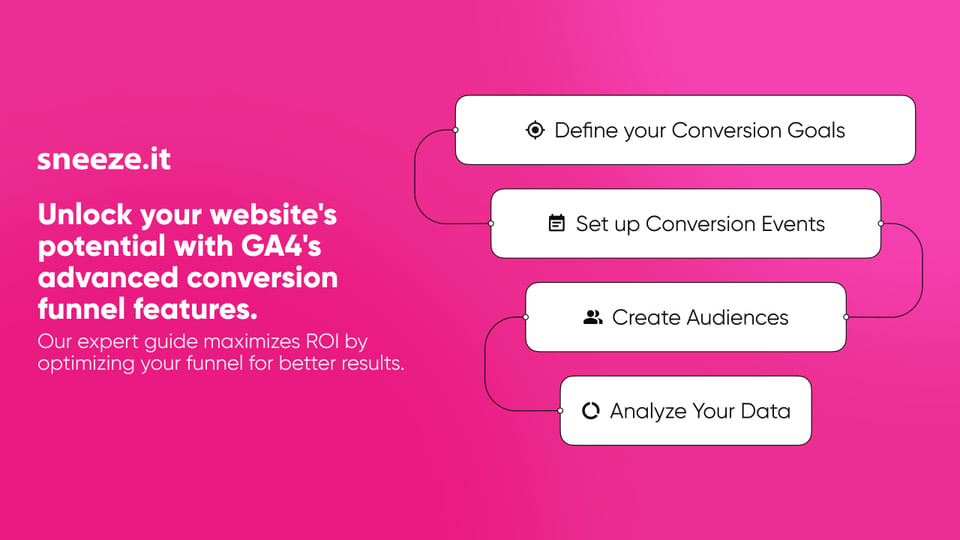Businesses need to have an online presence, especially since most people prefer to shop or access...
Recreating The Conversion Funnel for GA4

Welcome to our comprehensive guide on how to recreate the conversion funnel for GA4. As proficient SEO and high-end copywriters, we understand the importance of creating high-quality content that can outrank other websites on Google. Therefore, we have prepared this article to provide an in-depth understanding of optimizing your conversion funnel for GA4 to drive more leads and sales to your website.
What is a Conversion Funnel?
A conversion funnel is a framework used to visualize the customer journey, from the moment they become aware of your brand to the point where they make a purchase or take a desired action on your website. The conversion funnel is divided into several stages: awareness, interest, consideration, and action. Each stage represents a different customer journey phase and requires a specific strategy to optimize conversions.
Recreating the Conversion Funnel for GA4
Google Analytics 4 (GA4) is the latest version of Google Analytics that provides a more advanced way to track and analyze user behavior on your website. Unlike the previous version of Google Analytics, GA4 is designed to track user behavior across multiple devices and platforms, providing a more holistic view of the customer journey.
To recreate the conversion funnel for GA4, you need to set up conversion events that are triggered when users take specific actions on your website, such as making a purchase or filling out a form. These conversion events are then tracked and analyzed by GA4 to provide insights into the effectiveness of your marketing campaigns and website design.
Here are the steps to recreate the conversion funnel for GA4:
Step 1: Define your Conversion Goals
The first step in recreating the conversion funnel for GA4 is to define your conversion goals. What actions do you want users to take on your website? Do you want them to make a purchase, fill out a form, or sign up for a newsletter? Defining your conversion goals will help you create a more targeted conversion funnel optimized for your specific business objectives.
Step 2: Set up Conversion Events
Once you have defined your conversion goals, the next step is to set up conversion events in GA4. A conversion event is a specific action that users take on your website that you want to track as a conversion. Examples of conversion events include completing a purchase, filling out a form, or signing up for a newsletter.
To set up conversion events in GA4, you must create custom events triggered when users take specific actions on your website. These custom events can be set up using Google Tag Manager, a free tool that allows you to add and update tracking tags on your website.
Step 3: Create Audiences
After you have set up conversion events in GA4, the next step is to create audiences. An audience is a group of users who have taken a specific action on your website, such as completing a purchase or filling out a form. By creating audiences in GA4, you can segment your website traffic and target specific groups of users with personalized marketing messages.
Step 4: Analyze Your Data
Once you have set up your conversion goals, events, and audiences in GA4, the next step is to analyze your data. GA4 provides a range of advanced reporting features that allow you to track user behavior across multiple devices and platforms and gain insights into the effectiveness of your marketing campaigns and website design.
Some key metrics to track in GA4 include conversion rate, bounce rate, session duration, and average page views per session. By tracking these metrics, you can identify areas of your website that may be underperforming and make data-driven decisions to optimize your conversion funnel.
Recreating the conversion funnel for GA4 is an essential step in optimizing your website for conversions. By defining your conversion goals, setting up conversion events, creating audiences, and analyzing your data, you can create a more targeted and effective conversion funnel that drives more leads and sales to your website.
It's important to remember that optimizing your conversion funnel is an ongoing process that requires continuous monitoring and optimization. By regularly tracking and analyzing your data in GA4, you can identify areas for improvement and make data-driven decisions to optimize your conversion funnel.
Interesting in learning how to utilize Google Analytics to boost your business? Schedule a meeting with Dirk below!






.jpg?height=200&name=Blog%20post%20second%2030%20(1).jpg)
